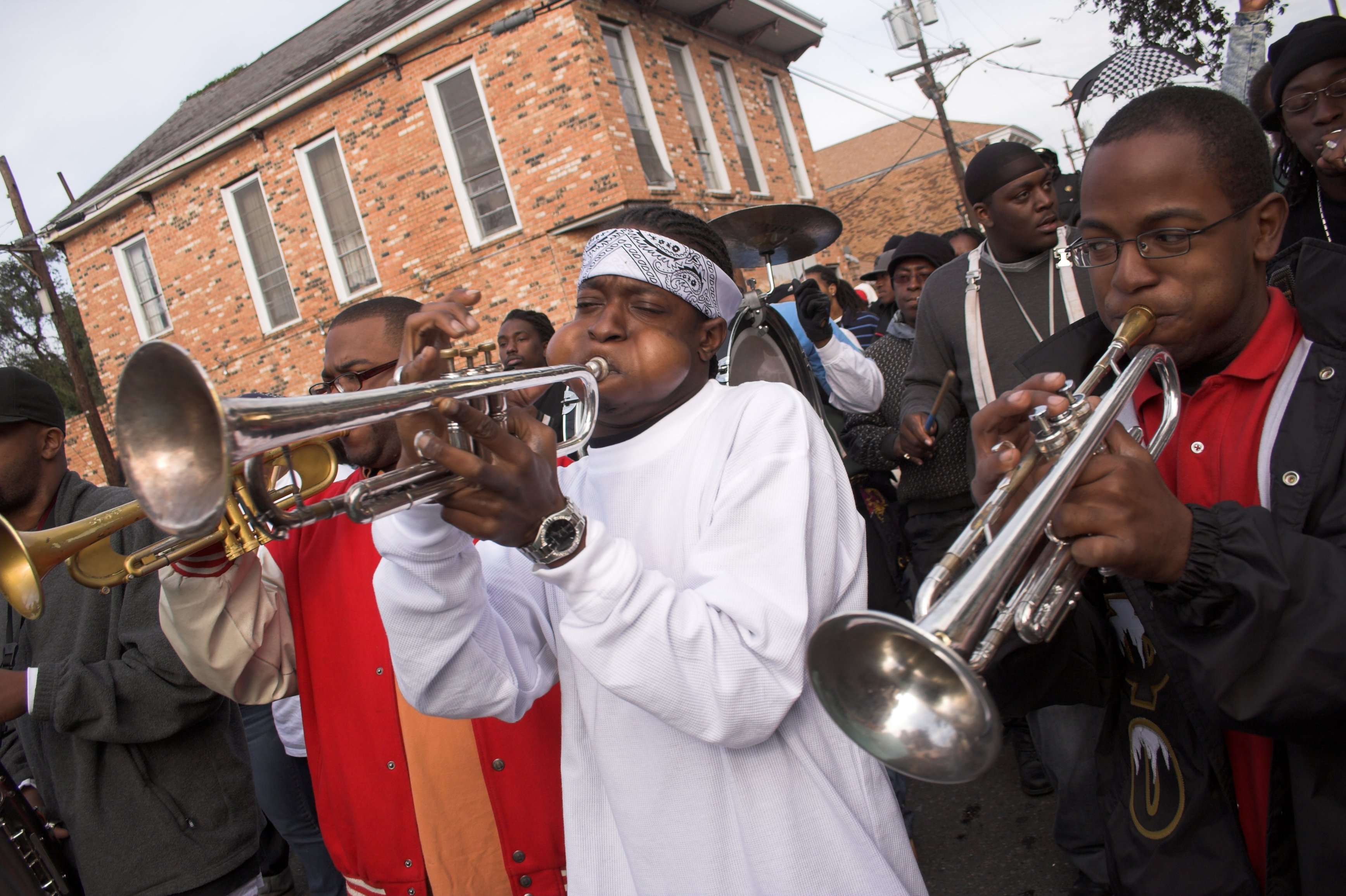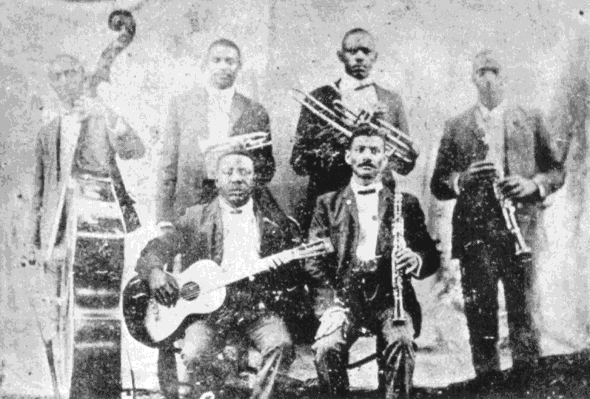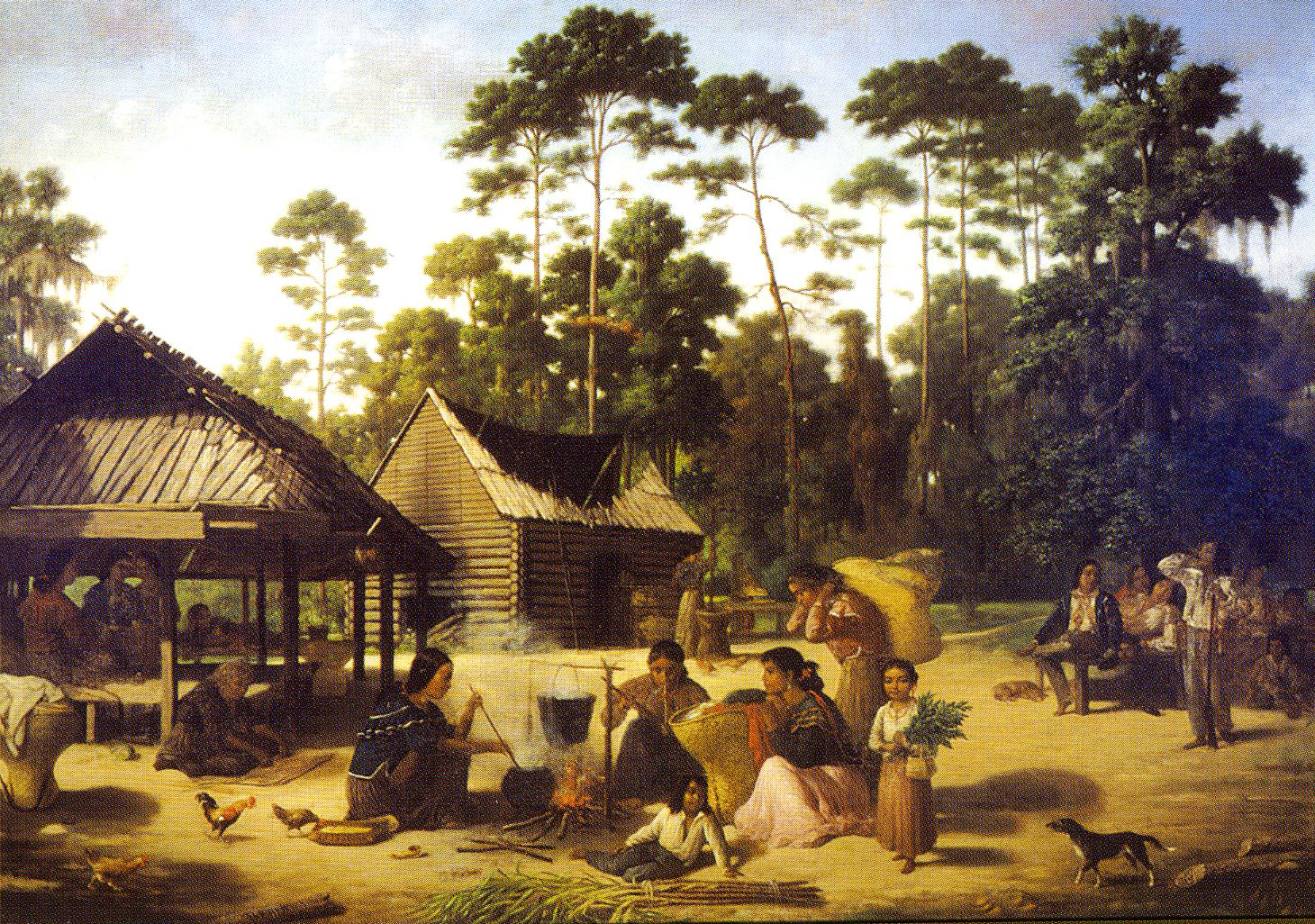|
Kid Ory And His Creole Band
Edward "Kid" Ory (December 25, 1886 – January 23, 1973) was an American jazz composer, trombonist and bandleader. One of the early users of the glissando technique, he helped establish it as a central element of New Orleans jazz. He was born near LaPlace, Louisiana and moved to New Orleans on his 21st birthday, to Los Angeles in 1910 and to Chicago in 1925. The Ory band later was an important force in reviving interest in New Orleans jazz, making radio broadcasts on ''The Orson Welles Almanac'' program in 1944, among other shows. In 1944–45, the group made a series of recordings for the Crescent label, which was founded by Nesuhi Ertegun for the express purpose of recording Ory's band. Ory retired from music in 1966 and spent his last years in Hawaii where he died from a heart attack. Biography Ory was born in 1886 to a Louisiana French-speaking family of Black Creole descent, on Woodland Plantation in Laplace, now the site of the 1811 Kid Ory Historic House. Ory sta ... [...More Info...] [...Related Items...] OR: [Wikipedia] [Google] [Baidu] |
LaPlace, Louisiana
LaPlace ( ) is a census-designated place (CDP) in St. John the Baptist Parish, Louisiana, United States, situated along the east bank of the Mississippi River, in the New Orleans metropolitan area. In 2020, it had a population of 28,841. LaPlace is the southern terminus of Interstate 55, where it joins with Interstate 10, and of US 51, where it terminates at the junction with US 61. LaPlace is located west of New Orleans. History Pre-European The Chitimacha lived in the region prior to the arrival of European colonists. The tribe’s lands once encompassed the entire Atchafalaya Basin, westward to Lafayette, southward to the Gulf of Mexico and eastward to the New Orleans area. The Chitimacha tribe currently resides on a reservation in St. Mary Parish. European colonization Present-day LaPlace was settled by German immigrants in the early 18th century during Louisiana's French colonial period, as part of a larger settlement on the bank of the Mississippi called K ... [...More Info...] [...Related Items...] OR: [Wikipedia] [Google] [Baidu] |
Music Of New Orleans
The music of New Orleans assumes various styles of music which have often borrowed from earlier traditions. New Orleans is especially known for its strong association with jazz music, universally considered to be the birthplace of the genre. The earliest form was dixieland, which has sometimes been called traditional jazz, 'New Orleans', or 'New Orleans jazz'. However, the tradition of jazz in New Orleans has taken on various forms that have either branched out from original dixieland or taken entirely different paths altogether. New Orleans has also been a prominent center of funk, home to some of the earliest funk bands such as the Meters. Background The African influence on New Orleans music can trace its roots at least back to Congo Square in New Orleans in 1835, when enslaved people would congregate there to play music and dance on Sundays. African music was primarily played as well as local music from varying sources such as adapted work songs, African American spiritua ... [...More Info...] [...Related Items...] OR: [Wikipedia] [Google] [Baidu] |
Joe "King" Oliver
Joseph Nathan "King" Oliver (December 19, 1881 – April 10, 1938) was an American jazz cornet player and bandleader. He was particularly recognized for his playing style and his pioneering use of mutes in jazz. Also a notable composer, he wrote many tunes still played today, including " Dippermouth Blues", "Sweet Like This", "Canal Street Blues", and " Doctor Jazz". He was the mentor and teacher of Louis Armstrong. His influence was such that Armstrong claimed, "if it had not been for Joe Oliver, jazz would not be what it is today." Biography Life Joseph Nathan Oliver was born in Aben, Louisiana, near Donaldsonville in Ascension Parish, to Nathan Oliver and Virginia "Jinnie" Jones. He claimed 1881 as his year of birth in his draft registration in September 1918 (two months before the end of World War I) but that year is open to debate, with some census records and other sources suggesting 1884 or 1885 as his true year of birth. He moved to New Orleans in his youth. He first ... [...More Info...] [...Related Items...] OR: [Wikipedia] [Google] [Baidu] |
Buddy Bolden
Charles Joseph "Buddy" Bolden (September 6, 1877 – November 4, 1931) was an American cornetist who was regarded by contemporaries and later jazz scholars as a key figure in the development of a New Orleans style of ragtime music, or "jass", which later came to be known as jazz. Childhood When he was born, Bolden's father, Westmore Bolden, was working as a driver for William Walker, the former employer of Buddy's grandfather Gustavus Bolden, who was born in Louisiana in 1806 and died in 1866. Gustavus was most likely born into slavery, though no definitive records say. His mother, Alice (née Harris), was aged 18 when she married Westmore on August 14, 1873. Westmore Bolden was around 25 at the time, as records show that he was 19 in August 1866. When Buddy was six years old, his father died, after which the boy lived with his mother and other family members. In records of the period the family name is variously spelled ''Bolen'', ''Bolding'', ''Boldan'', and ''Bolden'', t ... [...More Info...] [...Related Items...] OR: [Wikipedia] [Google] [Baidu] |
Cornet
The cornet (, ) is a brass instrument similar to the trumpet but distinguished from it by its conical bore, more compact shape, and mellower tone quality. The most common cornet is a transposing instrument in B. There is also a soprano cornet in E and cornets in A and C. All are unrelated to the Renaissance and early Baroque cornett. History The cornet was derived from the posthorn by applying valves to it in the 1820s. Initially using Stölzel valves, by the 1830s, Parisian makers were using the improved Périnet piston valves. Cornets first appeared as separate instrumental parts in 19th-century French compositions.''Encyclopædia Britannica'', Micropedia, Volume III, William Benton, Chicago Illinois, 1974, p. 156 The instrument could not have been developed without the improvement of piston valves by Silesian horn players Friedrich Blühmel (or Blümel) and Heinrich Stölzel, in the early 19th century. These two instrument makers almost simultaneously invented valv ... [...More Info...] [...Related Items...] OR: [Wikipedia] [Google] [Baidu] |
Banjo
The banjo is a stringed instrument with a thin membrane stretched over a frame or cavity to form a resonator. The membrane is typically circular, and in modern forms is usually made of plastic, where early membranes were made of animal skin. Early forms of the instrument were fashioned by African Americans and had African antecedents. In the 19th century, interest in the instrument was spread across the United States and United Kingdom by traveling shows of the 19th-century minstrel show fad, followed by mass production and mail-order sales, including instructional books. The inexpensive or home-made banjo remained part of rural folk culture, but five-string and four-string banjos also became popular for home parlor music entertainment, college music clubs, and early 20th century jazz bands. By the early 20th century, the banjo was most frequently associated with folk, cowboy music, and country music. By mid-century it had come to be strongly associated with bluegrass. Eventu ... [...More Info...] [...Related Items...] OR: [Wikipedia] [Google] [Baidu] |
New Orleans
New Orleans (commonly known as NOLA or The Big Easy among other nicknames) is a Consolidated city-county, consolidated city-parish located along the Mississippi River in the U.S. state of Louisiana. With a population of 383,997 at the 2020 United States census, 2020 census, it is the List of municipalities in Louisiana, most populous city in Louisiana and the French Louisiana region, the second-most populous in the Deep South, and the twelfth-most populous in the Southeastern United States. The city is coextensive with Orleans Parish, Louisiana, Orleans Parish. New Orleans serves as a major port and a commercial hub for the broader Gulf Coast of the United States, Gulf Coast region. The New Orleans metropolitan area has a population of approximately 1 million, making it the most populous metropolitan area in Louisiana and the List of metropolitan statistical areas, 59th-most populous in the United States. New Orleans is world-renowned for Music of New Orleans, its distincti ... [...More Info...] [...Related Items...] OR: [Wikipedia] [Google] [Baidu] |
Louisiana
Louisiana ( ; ; ) is a state in the Deep South and South Central regions of the United States. It borders Texas to the west, Arkansas to the north, and Mississippi to the east. Of the 50 U.S. states, it ranks 31st in area and 25th in population, with roughly 4.6 million residents. Reflecting its French heritage, Louisiana is the only U.S. state with political subdivisions termed parishes, which are equivalent to counties, making it one of only two U.S. states not subdivided into counties (the other being Alaska and its boroughs). Baton Rouge is the state's capital, and New Orleans, a French Louisiana region, is its most populous city with a population of about 363,000 people. Louisiana has a coastline with the Gulf of Mexico to the south; a large part of its eastern boundary is demarcated by the Mississippi River. Much of Louisiana's lands were formed from sediment washed down the Mississippi River, leaving enormous deltas and vast areas of coastal marsh a ... [...More Info...] [...Related Items...] OR: [Wikipedia] [Google] [Baidu] |
1811 Kid Ory Historic House
The Bonnet Carre Historical Center, also known as the 1811 Kid Ory Historic House, is a museum in LaPlace, Louisiana, housed in a historic plantation house formerly known by names including Andry Plantation and Woodland Plantation. It focuses on the 1811 German Coast uprising, which Charles Deslondes started there, and the life of jazz pioneer Kid Ory, born here in 1886. Other exhibits include antique phonographs and history of plantation life. The museum was originally operated by former journalist John McCusker and, after a temporary closure during the COVID-19 pandemic, reopened under the auspices of the historical center with support from the agribusiness firm Greenfield Louisiana. The museum once again closed in October 2022 due prohibitive costs resulting from the aftermath of Hurricane Ida Hurricane Ida was a deadly and extremely destructive tropical cyclone in 2021 that became the second-most damaging and intense hurricane to make landfall in the U.S. state of Loui ... [...More Info...] [...Related Items...] OR: [Wikipedia] [Google] [Baidu] |
Woodland Plantation (Laplace, Louisiana)
Woodland Plantation may refer to: ;in the United States * Woodland Plantation (West Pointe a la Hache, Louisiana), listed on the NRHP in Louisiana * Woodland Plantation in LaPlace, Louisiana; played a role in the 1811 German Coast uprising; birthplace of Kid Ory Edward "Kid" Ory (December 25, 1886 – January 23, 1973) was an American jazz composer, Trombone, trombonist and bandleader. One of the early users of the glissando technique, he helped establish it as a central element of Music of New Orle ... * Woodland Plantation (Church Hill, Mississippi), listed on the NRHP in Mississippi * Woodland Plantation (Carlisle, South Carolina), listed on the NRHP in South Carolina {{disambig ... [...More Info...] [...Related Items...] OR: [Wikipedia] [Google] [Baidu] |
Creoles Of Color
The Creoles of color are a multiracial ethnic group of Louisiana Creoles that developed in the former French and Spanish colonies of Louisiana (especially in New Orleans), Mississippi, Alabama, and Northwestern Florida, in what is now the United States. French colonists in Louisiana first used the term " Creole" to refer to people born in the colony, rather than in Europe, thus drawing a distinction between Old-World Europeans and Africans from their descendants born in the New World.Kathe ManaganThe Term "Creole" in Louisiana : An Introduction, lameca.org. Retrieved December 5, 2013 Today, many Creoles of color have assimilated into (and contributed to) Black American culture, while some retain their distinct identity as a subset within the broader African American ethnic group. New Orleans Creoles of color have been named as a "vital source of U.S. national-indigenous culture." Creoles of color helped produce the historic cultural pattern of unique literature, art, music, arc ... [...More Info...] [...Related Items...] OR: [Wikipedia] [Google] [Baidu] |
Louisiana French
Louisiana French (Louisiana French: ''français louisianais''; ) includes the dialects and varieties of the French language spoken traditionally by French Louisianians in colonial Lower Louisiana. As of today Louisiana French is primarily used in the state of Louisiana, specifically in its southern parishes. Over the centuries, the language has incorporated some words of African, Spanish, Native American and English origin, sometimes giving it linguistic features found only in Louisiana.Thomas A. Klingler, Michael Picone and Albert Valdman. "The Lexicon of Louisiana French." ''French and Creole in Louisiana''. Albert Valdman, ed. Springer, 1997. 145-170.Thomas A. Klingler.Language labels and language use among Cajuns and Creoles in Louisiana" Ed. T. Sanchez and U. Horesh. ''Working papers in linguistics'' 9(2), 2003. 77–90. Louisiana French differs to varying extents from French dialects spoken in other regions, but Louisiana French is mutually intelligible with other di ... [...More Info...] [...Related Items...] OR: [Wikipedia] [Google] [Baidu] |






